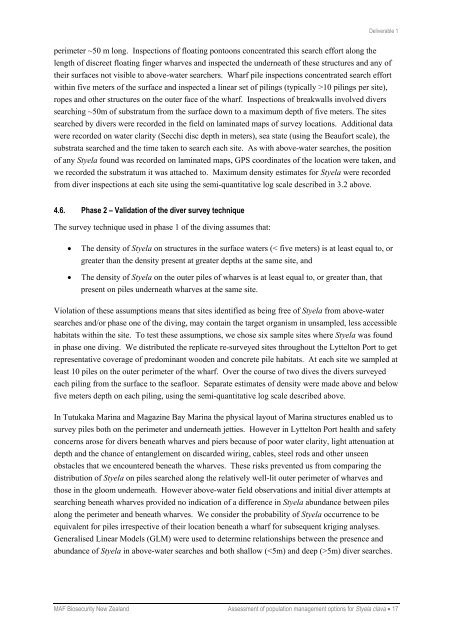Assessment of population management options for Styela clava
Assessment of population management options for Styela clava
Assessment of population management options for Styela clava
Create successful ePaper yourself
Turn your PDF publications into a flip-book with our unique Google optimized e-Paper software.
Deliverable 1<br />
perimeter ~50 m long. Inspections <strong>of</strong> floating pontoons concentrated this search ef<strong>for</strong>t along the<br />
length <strong>of</strong> discreet floating finger wharves and inspected the underneath <strong>of</strong> these structures and any <strong>of</strong><br />
their surfaces not visible to above-water searchers. Wharf pile inspections concentrated search ef<strong>for</strong>t<br />
within five meters <strong>of</strong> the surface and inspected a linear set <strong>of</strong> pilings (typically >10 pilings per site),<br />
ropes and other structures on the outer face <strong>of</strong> the wharf. Inspections <strong>of</strong> breakwalls involved divers<br />
searching ~50m <strong>of</strong> substratum from the surface down to a maximum depth <strong>of</strong> five meters. The sites<br />
searched by divers were recorded in the field on laminated maps <strong>of</strong> survey locations. Additional data<br />
were recorded on water clarity (Secchi disc depth in meters), sea state (using the Beau<strong>for</strong>t scale), the<br />
substrata searched and the time taken to search each site. As with above-water searches, the position<br />
<strong>of</strong> any <strong>Styela</strong> found was recorded on laminated maps, GPS coordinates <strong>of</strong> the location were taken, and<br />
we recorded the substratum it was attached to. Maximum density estimates <strong>for</strong> <strong>Styela</strong> were recorded<br />
from diver inspections at each site using the semi-quantitative log scale described in 3.2 above.<br />
4.6. Phase 2 – Validation <strong>of</strong> the diver survey technique<br />
The survey technique used in phase 1 <strong>of</strong> the diving assumes that:<br />
• The density <strong>of</strong> <strong>Styela</strong> on structures in the surface waters (< five meters) is at least equal to, or<br />
greater than the density present at greater depths at the same site, and<br />
• The density <strong>of</strong> <strong>Styela</strong> on the outer piles <strong>of</strong> wharves is at least equal to, or greater than, that<br />
present on piles underneath wharves at the same site.<br />
Violation <strong>of</strong> these assumptions means that sites identified as being free <strong>of</strong> <strong>Styela</strong> from above-water<br />
searches and/or phase one <strong>of</strong> the diving, may contain the target organism in unsampled, less accessible<br />
habitats within the site. To test these assumptions, we chose six sample sites where <strong>Styela</strong> was found<br />
in phase one diving. We distributed the replicate re-surveyed sites throughout the Lyttelton Port to get<br />
representative coverage <strong>of</strong> predominant wooden and concrete pile habitats. At each site we sampled at<br />
least 10 piles on the outer perimeter <strong>of</strong> the wharf. Over the course <strong>of</strong> two dives the divers surveyed<br />
each piling from the surface to the seafloor. Separate estimates <strong>of</strong> density were made above and below<br />
five meters depth on each piling, using the semi-quantitative log scale described above.<br />
In Tutukaka Marina and Magazine Bay Marina the physical layout <strong>of</strong> Marina structures enabled us to<br />
survey piles both on the perimeter and underneath jetties. However in Lyttelton Port health and safety<br />
concerns arose <strong>for</strong> divers beneath wharves and piers because <strong>of</strong> poor water clarity, light attenuation at<br />
depth and the chance <strong>of</strong> entanglement on discarded wiring, cables, steel rods and other unseen<br />
obstacles that we encountered beneath the wharves. These risks prevented us from comparing the<br />
distribution <strong>of</strong> <strong>Styela</strong> on piles searched along the relatively well-lit outer perimeter <strong>of</strong> wharves and<br />
those in the gloom underneath. However above-water field observations and initial diver attempts at<br />
searching beneath wharves provided no indication <strong>of</strong> a difference in <strong>Styela</strong> abundance between piles<br />
along the perimeter and beneath wharves. We consider the probability <strong>of</strong> <strong>Styela</strong> occurrence to be<br />
equivalent <strong>for</strong> piles irrespective <strong>of</strong> their location beneath a wharf <strong>for</strong> subsequent kriging analyses.<br />
Generalised Linear Models (GLM) were used to determine relationships between the presence and<br />
abundance <strong>of</strong> <strong>Styela</strong> in above-water searches and both shallow (5m) diver searches.<br />
MAF Biosecurity New Zealand <strong>Assessment</strong> <strong>of</strong> <strong>population</strong> <strong>management</strong> <strong>options</strong> <strong>for</strong> <strong>Styela</strong> <strong>clava</strong> • 17
















